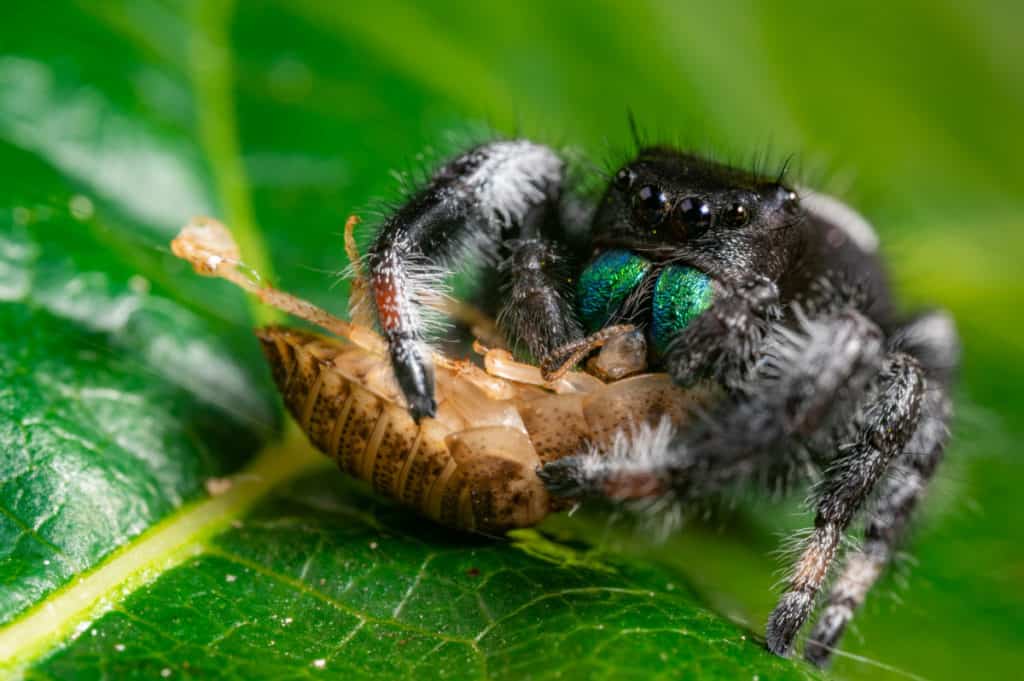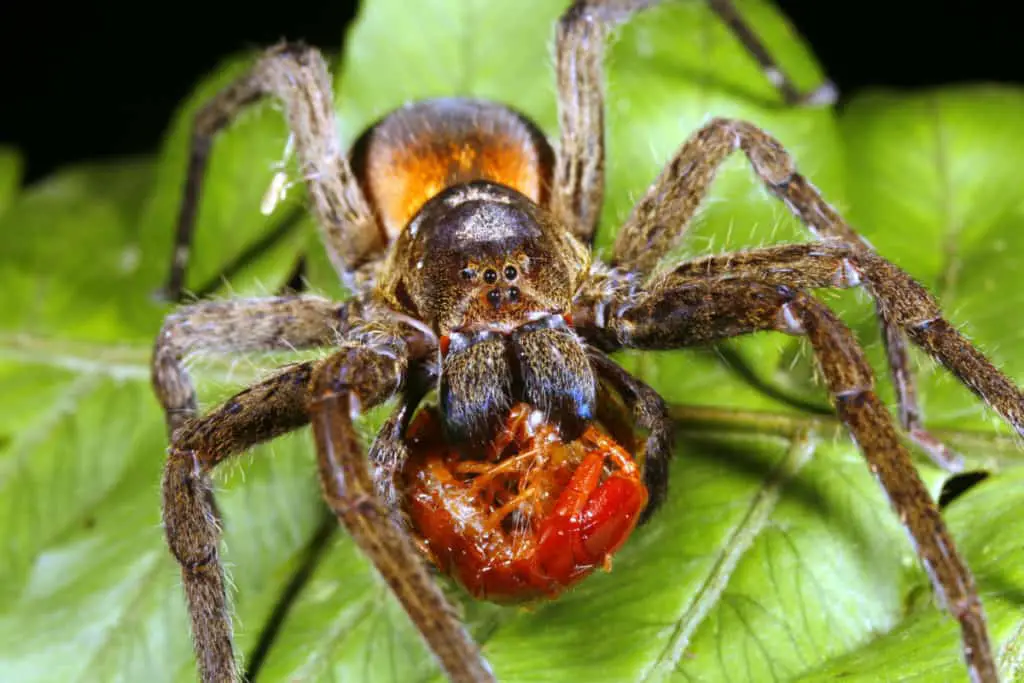You’ve probably seen many spiders in your life, but have you ever been curious about their anatomies? – For example, have you ever wondered if spiders have tongues and how they eat food?
Spiders belong to the order of Araneae with unique anatomies. The air-breathing arthropods don’t have tongues the way humans do, so they have to make up for the tongue’s functions in different ways. They taste their food with their legs and swallow it through suction movements created by their stomach. They turn their prey into a liquid so that they don’t need to chew it.

Read on to find more about the spider’s mouth anatomy and its different parts and functions. We’ll talk about how spiders taste and eat their food and how they drink water.
Spiders’ Mouth Anatomy
As arachnids, the spider’s body has two segments: the cephalothorax, a hybrid between a head and a thorax, and an abdomen with eight legs attached to it.
Spiders don’t have tongues like humans or many other animals. Their mouths consist of fang-shaped jaws with sharp edges called the chelicerae. These finely serrated jaws are located below the spider’s eyes and help hold and crush the prey.
Spiders use their fangs in two ways. Some species have their fangs pointing down with vertical movements for opening and closing, while others move their jaws horizontally like a pincer. These movements allow the spider to shred its prey and turn it into a mushy bolus.

Inside the chelicerae, the spider has glands that store its venom. Spiders selectively use different venom compositions to defend themselves, subdue their prey, and digest their food.
Below and behind the chelicerae, spiders have two flat cuticle blocks. The upper part is the upper lip called the labrum. The lower plate, which covers the upper lip, is called the labium.
Inside the lips, the spider’s mouth looks like a tube and opens behind the jaws. There’s a row of teeth on the labium’s front end. Their hair-covered edge works like filters that don’t allow solid food to go into the spider’s mouth.
You have an idea of the mouth anatomy now but what about the other end? We often get asked the question of whether spiders poop. If you are interested we have answered this in another article we wrote called, Do Spiders Poop?
How Do Spiders Handle Food?
There are two appendages called pedipalps at the front of the cephalothorax between the chelicerae and the first pair of legs. These segmented parts are shorter than the legs and act like arms for spiders to hold and handle food.
These organs also function as taste sensing tools for spiders; that’s why they’re also called feelers. They have chemical detectors that are highly sensitive and help spiders taste and smell food.
For more on spider appendages and how their bodies are protected by a kind of body armor check out this article we have written, Do Spiders Have Bones?
How Do Spiders Eat?
Spiders don’t have jaw-like body parts to chew their food. Therefore, the food they eat has to be in liquid form. They use two interestingly distinct ways to eat and digest their food. They either mash the prey with their jaws after dousing it by drooling digestive fluid over it. This way, they predigest the food to turn it into liquid.
Some other spiders, such as cobweb weavers and crab spiders, can’t crush their prey because their jaws are small, and they don’t have teeth.
Web spiders don’t have strong pedipalps, and they can’t hold their prey on the ground or a hard surface. So, they wrap their prey with their silk to make sure it can’t move. Then, they create small holes in the prey’s body with their fangs and inject the digestive substances inside their food’s body to liquefy its internal parts.
They then suck out the predigested parts through their mouth orifice and leave a hollow shell from the prey’s body.
The stomach creates the sucking motion a spider needs to eat its food. It has dilation muscles that work like a pump to facilitate the sucking action. The food then goes to the foregut, which stores the food. The sucking stomach sends digestive fluid up and down the digestive tract to help with digestion.
After the foregut, there’s the hindgut, which completes the digestion process.
If you are interested we have a complete guide to the diet of spiders. If you want to check it out the article is called, What Do Spiders Eat?
Can Spiders Taste Food?
Although spiders don’t have tongues, they have developed some other methods to taste the food. As we mentioned earlier, spiders use their pedipalps to taste and smell food.
But those aren’t the only organs that have gustatory functions. Spiders have sensory organs in their legs, too. There are taste-sensitive hairs on their legs that help them taste their prey. This way, they can make sure the food is edible and distinguish good-tasting from bad-tasting foods.
But they don’t have the same sense of good and bad taste as we do because, by the time they eat the prey, it’s been mixed with their venom and doesn’t have a specific “taste.” For them, good taste and bad taste mean edible and inedible. They typically avoid acidic foods.
They also use these receptors to find their prey by sensing their smell in the air. This means that spiders don’t necessarily need light to hunt their prey in fact some spiders prefer to hunt their prey at night.
Do you think spiders like the taste of cockroaches? Are there spiders in your house that will eat roaches? If you are interested we have written an entire article on this topic, it’s called Do Spiders Eat Roaches?
Do Spiders Drink Water?
Spiders need to drink water to stay hydrated. They mostly rely on the water in the prey’s body. Spiders who live in the wild drink water from any water source they can find, even the rainwater or dew accumulated on their webs.
When a spider needs to drink water, it puts its legs and palps on or near the water source. The hairs on its legs allow it to stay on the water. Spiders drink water the same way they eat food (since their food is always liquid). They extend their straw-like mouth orifice and suck up the water.
We have a whole article on spiders drinking water. We have a great video of a jumping spider drinking water, it’s worth a look.
The Wrap Up
Spiders have unique anatomies that make them perfect for their small world. A spider’s mouth is located on the cephalothorax’s front part below the eyes and the chelicerae.
Since spiders don’t have tongues, they use their pedipalps and legs to smell and taste their food. There are taste-sensing hairs on their legs that allow them to locate their prey by smelling them and deciding if they’re consumable by tasting them.
Spiders have a liquid diet, so they have to turn their prey into liquid and slurp it. They use their venoms to liquidize the prey’s innards either by piercing their bodies through their fangs or vomiting their digestive fluid on them.
Do you live in Michigan or Utah?
This might interest you. We have compiled a complete guide to the spiders you are likely to find in your state. Check them out below:
Spiders You Might Find in Michigan. A Complete Guide
What Spiders Can Be Found in Utah and How Many Are Poisonous?
Sources
https://www.discoverwildlife.com/animal-facts/insects-invertebrates/facts-about-spiders/
https://www.britannica.com/animal/arachnid#ref47817
https://animals.mom.com/kind-mouth-spider-have-11112.html
https://www.welcomewildlife.com/spider-basics/
https://australian.museum/learn/animals/spiders/spider-structure/
